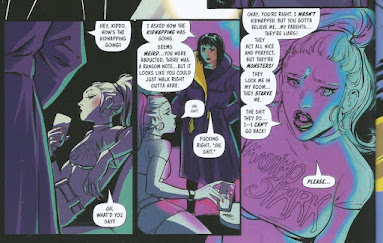The striking coat should give you a clue that we’re in science fiction territory. Though the science is within the realm of a ten year possibility.
The opening gambit doesn’t appear to be linked to the gist of Bylines. At least, not yet. I haven't ruled out that, given the depth of time spent upon Satya's previous case, the scenario may connect.
So far, the prologue serves as a spectacular James Bond styled entrance.
Damn! That’s the action I’m craving, and there's more where that came from.
Notice how Aneke's colors enhance Jen Van Jensen's cracking artwork.
In black and white, the image would have been exciting. The color grants expressive electricity.
After closing this case, Satya returns to her office where the creative team germinate the main story.
Within this narrative, Schultz fleshes out Satya’s history and reflects the future-tense against our own reality.
Reporters often substitute for private detectives and sleuths in countless mysteries. I don't believe I ever encountered an actual reporter turned private eye in the literature.
Satya's origins are surprisingly sensible. The internet didn't kill the newspaper. Television struck the first blow. The internet then skewered the liver.
Newspapers lacking capital unlike say The New York Times could not adapt. The story didn't end there. Conservative vultures picked over the carcass. Newspapers that once stood for truth and justice, like my once beloved Post-Gazette, now exalt Donald Trump and other authoritarians.
It's easy to see how a reporter dedicated to the truth would become disillusioned by a world that seemed not to want such a thing. It's easy to see how Satya though claiming to only want to be paid, still seeks the truth as a private investigator, or "lady dick" as she's amusingly referred to.
With the facts and protagonist established, Schultz and company begin unfolding the tale of how a man can be mysteriously murdered in a society that’s so watchful.
Schultz studied her subject. The shamus observes the world. Hunts for the truth. The gumshoe often contends with and/or exposes counter-culture to the reader or the audience. The detective travels where polite society fears to tread.
Dick Powell’s Phillip Marlowe for example in Murder, My Sweet faces the hallucinogenic drugs of a seedy psychiatrist. The renamed Lew Archer played by Paul Newman encounters a strange cult in Harper. Even way back in the day, Sherlock Holmes uncovered data in opium dens.
Satya relies on an organization fitting for Schultz’s, Van Jensen’s and Aneke’s reshaped wold.
The Truthers are an intriguing lot that hearken back to "Farewell to the Master," the basis for The Day the Earth Stood Still. The gist is that these people don't trust themselves enough to relate objective truth. They've created machines to watch and record.
The Truth, which some believe to be tenuous and subjective, is the very building block of history.
History as they say is written by the victors. No. They is wrong. History exists. The present day is the result of history. There is an objectively evolving history. It's just as substantive as atoms are in the makeup of the universe. Don't let anybody tell you otherwise. Facts matter, and that's the underlying message threading Bylines in Blood.








No comments:
Post a Comment